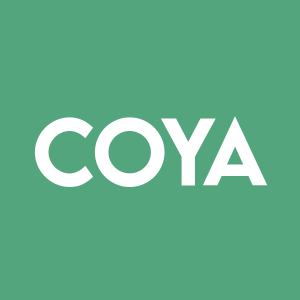Coya Therapeutics Reports Statistically Significant Improvement of Inflammatory Blood Markers in Patients with Alzheimer’s Disease Following Monthly Dosing with Low-Dose IL-2, Further Supporting Clinical Development
Investigator-initiated data from Houston Methodist Hospital showed LD IL-2 reduced proinflammatory factors, both systemically and within the central nervous system, while demonstrating statistically significant improvement in beta amyloid 42 clearance with stabilization of cognitive decline over a five-month treatment period
Comprehensive data set will be presented and released throughout 2025 and in a peer reviewed publication
Statistically significant reduced levels of proinflammatory markers were observed in patients receiving a five-day treatment of subcutaneous LD IL-2 on a monthly cycle in comparison to a biweekly 5-day administration or placebo. Lower blood levels of the proinflammatory chemokine (C-C motif) ligand 2 (CCL2) (p<0.05) and proinflammatory cytokine IL-15 (p <0.001) were statistically significant, and a statistically significant increase in the anti-inflammatory cytokine IL-4 (p<0.01) in patients receiving monthly cycles of LD IL-2 was observed, compared to patients receiving placebo. At the end of the five-month treatment period when treatment was removed, the anti-inflammatory benefits reverted back to placebo levels. In addition, patients receiving LD IL-2 cycles at the higher biweekly frequency showed a smaller impact on these factors compared to monthly LD IL-2, supporting the potential beneficial effects of monthly LD IL-2.
"We believe the reduction of proinflammatory factors within peripheral blood corresponding with significant improvement in beta amyloid 42 in the cerebrospinal fluid and cognitive stabilization during LD IL-2 therapy underscores the importance of targeting regulatory T cells in Alzheimer’s disease. We believe LD IL-2 offers an immunomodulatory strategy that enhances Treg function for potentially treating Alzheimer’s disease and several other neurodegenerative disorders,” commented Coya CMO Fred Grossman, DO.
The statistically significant improvement in serum inflammatory markers corresponded with previously-reported findings from AD patients receiving monthly LD IL-2 compared to patients receiving biweekly LD IL-2 or placebo. Monthly LD IL-2 showed an increase in Aβ42 levels in cerebrospinal fluid (CSF), suggesting increased clearance of amyloid-β, stable levels of neurofilament light chain (NfL) in CSF, and statistically significant Treg expansion, all demonstrating targeted biological activity. In addition, patients receiving monthly LD IL-2 showed a 4.93-point improvement in the ADAS-Cog score compared to placebo over the 21-week treatment period.
Topline results from this investigator-initiated study were presented in October 2024 at the Clinical Trials on Alzheimer’s Disease Conference (CTAD) in
LD IL-2 was well-tolerated and no serious adverse events (SAEs) or deaths were reported. The most common AEs were mild injection site reactions and a mild increase in eosinophil counts.
LD IL-2 plays a key role in the expansion and immunomodulatory function of Tregs in vivo. LD IL-2 binds to the high affinity interleukin-2 receptor α-chain (IL-2Rα; CD25), which is mainly expressed in Tregs. In contrast, higher doses of IL-2 also bind to the lower affinity IL-2Rβ (CD122), which stimulates proinflammatory T cells and NK cells. The improved biological and clinical effects experienced by patients receiving monthly LD IL-2 administration could be due to selective expansion of Tregs at lower doses, while higher IL-2 doses activate pro-inflammatory pathways.
Coya plans to publish and present the results of this study throughout 2025.
Coya CEO Arun Swaminathan, Ph.D., added, "While monotherapy with LD IL-2 shows targeted improvement in biological activity in patients with AD, as demonstrated in this early Phase 2 academic study, we think that combining our proprietary LD IL-2 (COYA 301) with several other immunomodulatory modalities could deliver additive or even synergistic targeted effects."
Summary of Study Design
The investigator-initiated, randomized, double-blind, placebo-controlled Phase 2 trial evaluated two dosing regimens of subcutaneous LD IL-2 in 38 participants with Alzheimer’s disease that were between the ages of 50 to 86 and had Mini-Mental State Examination (MMSE) scores ranging from 12 to 26.
Of the 38 total participants, 22 were randomized in a 1:1 ratio to receive either five days of LD IL-2 (106 IU/day) (LD IL-2 q4wks) or placebo every four weeks for 21 weeks. An additional 16 participants were randomized in a 2:1 ratio to receive 5-day cycles of LD IL-2 every two weeks (LD IL-2 q2wks) or placebo for the same 21-week duration. All participants were monitored for nine weeks post-treatment, resulting in a total study period of 30 weeks. Demographics and baseline disease characteristics were comparable among the treatment groups.
The primary endpoint was the incidence and severity of adverse events (AEs), with the secondary endpoint evaluating changes in Tregs. Exploratory endpoints assessed changes in cerebrospinal fluid (CSF), AD-related biomarkers, and cognitive status.
About COYA 301
COYA 301 is the company’s proprietary investigational low-dose interleukin-2 (IL-2) intended to enhance the anti-inflammatory function of regulatory T cells (Tregs) and is designed for subcutaneous administration. COYA 301 is an investigational product not yet approved by the FDA or any other regulatory agency.
About COYA 302
COYA 302 is an investigational and proprietary biologic combination therapy with a dual immunomodulatory mechanism of action intended to enhance the anti-inflammatory function of regulatory T cells (Tregs) and suppress the inflammation produced by activated monocytes and macrophages. COYA 302 is comprised of proprietary low-dose interleukin-2 (LD IL-2) and cytotoxic T lymphocyte-associated antigen 4 immunoglobulin fusion protein (CTLA4-Ig) and is being developed for subcutaneous administration for the treatment of patients with ALS, FTD, Parkinson’s Diseases (PD), and Alzheimer’s disease. These mechanisms may have additive or synergistic effects.
In February of 2023, Coya announced results from a proof-of-concept, open-label clinical study evaluating commercially available LD IL-2 and CTLA4-Ig in a small cohort of patients with ALS conducted at the Houston Methodist Research Institute (
During the 48-week treatment period, the therapy was well tolerated. The most common adverse event was mild injection-site reactions. No patient discontinued the study, and no deaths or other serious adverse events were reported.
Patients' disease progression was measured using the ALSFRS-R scale, a validated rating tool for monitoring the progression of disability in patients with ALS. The mean (±SD) ALSFRS-R scores at week 24 (33.75 ±3.3) and week 48 (32 ±7.8) after initiation of treatment were not statistically different compared to the ALSFRS-R score at baseline (33.5 ±5.9), suggesting significant amelioration in the progression of the disease over the 48-week treatment period.
Treg suppressive function, expressed as a percentage of inhibition of proinflammatory T cell proliferation, showed a statistically significant increase over the course of the treatment period and was significantly reduced at the end of the 8-week washout post-treatment period. Treg suppressive function at 24 weeks (79.9 ±9.6) and 48 weeks (89.5 ±4.1) were significantly higher compared to baseline (62.1 ±8.1) (p<0.01), suggesting enhanced and durable Treg suppressive function over the course of treatment. In contrast, Treg suppressive function (mean ±SD) was significantly decreased at the end of the 8-week washout period compared to end-of-treatment at week 48 (70.3±8.1 vs. 89.5±4.1, p <0.05).
The study also evaluated serum biomarkers of inflammation, oxidative stress, and lipid peroxides. The available data up to 16 weeks after initiation of treatment suggest a decrease in these biomarker levels, which is consistent with the observed enhancement of Treg function. The evaluation of the full biomarker data is ongoing.
COYA 302 is an investigational product not yet approved by the FDA or any other regulatory agency.
About Coya Therapeutics, Inc.
Headquartered in
Coya’s investigational product candidate pipeline leverages multiple therapeutic modalities aimed at restoring the anti-inflammatory and immunomodulatory functions of Tregs. Coya’s therapeutic platforms include Treg-enhancing biologics, Treg-derived exosomes, and autologous Treg cell therapy.
For more information about Coya, please visit www.coyatherapeutics.com
Forward-Looking Statements
This press release contains “forward-looking” statements that are based on our management’s beliefs and assumptions and on information currently available to management. Forward-looking statements include all statements other than statements of historical fact contained in this presentation, including information concerning our current and future financial performance, business plans and objectives, current and future clinical and preclinical development activities, timing and success of our ongoing and planned clinical trials and related data, the timing of announcements, updates and results of our clinical trials and related data, our ability to obtain and maintain regulatory approval, the potential therapeutic benefits and economic value of our product candidates, competitive position, industry environment and potential market opportunities. The words “believe,” “may,” “will,” “estimate,” “continue,” “anticipate,” “intend,” “expect,” and similar expressions are intended to identify forward-looking statements.
Forward-looking statements are subject to known and unknown risks, uncertainties, assumptions and other factors including, but not limited to, those related to risks associated with the success, cost and timing of our product candidate development activities and ongoing and planned clinical trials; our plans to develop and commercialize targeted therapeutics; the progress of patient enrollment and dosing in our preclinical or clinical trials; the ability of our product candidates to achieve applicable endpoints in the clinical trials; the safety profile of our product candidates; the potential for data from our clinical trials to support a marketing application, as well as the timing of these events; our ability to obtain funding for our operations; development and commercialization of our product candidates; the timing of and our ability to obtain and maintain regulatory approvals; the rate and degree of market acceptance and clinical utility of our product candidates; the size and growth potential of the markets for our product candidates, and our ability to serve those markets; our commercialization, marketing and manufacturing capabilities and strategy; future agreements with third parties in connection with the commercialization of our product candidates; our expectations regarding our ability to obtain and maintain intellectual property protection; our dependence on third party manufacturers; the success of competing therapies or products that are or may become available; our ability to attract and retain key scientific or management personnel; our ability to identify additional product candidates with significant commercial potential consistent with our commercial objectives; ; and our estimates regarding expenses, future revenue, capital requirements and needs for additional financing.
We have based these forward-looking statements largely on our current expectations and projections about future events and trends that we believe may affect our financial condition, results of operations, business strategy, short-term and long-term business operations and objectives, and financial needs. Moreover, we operate in a very competitive and rapidly changing environment, and new risks may emerge from time to time. It is not possible for our management to predict all risks, nor can we assess the impact of all factors on our business or the extent to which any factor, or combination of factors, may cause actual results to differ materially from those contained in any forward-looking statements we may make. In light of these risks, uncertainties and assumptions, the forward-looking events and circumstances discussed herein may not occur and actual results could differ materially and adversely from those anticipated or implied in the forward-looking statements. Although our management believes that the expectations reflected in our forward-looking statements are reasonable, we cannot guarantee that the future results, levels of activity, performance or events and circumstances described in the forward-looking statements will be achieved or occur. We undertake no obligation to publicly update any forward-looking statements, whether written or oral, that may be made from time to time, whether as a result of new information, future developments or otherwise.
View source version on businesswire.com: https://www.businesswire.com/news/home/20250206168584/en/
Investor Contact
David
david@coyatherapeutics.com
CORE IR
Bret Shapiro
brets@coreir.com
561-479-8566
Media Contacts
For Coya Therapeutics:
Kati Waldenburg
media@coyatherapeutics.com
212-655-0924
Source: Coya Therapeutics, Inc.







